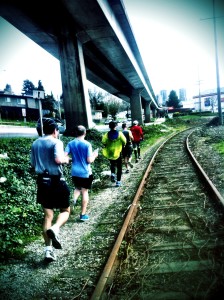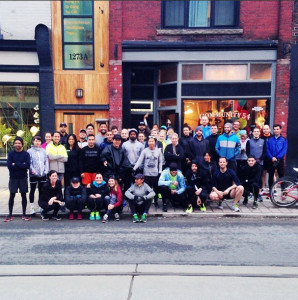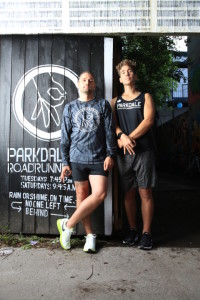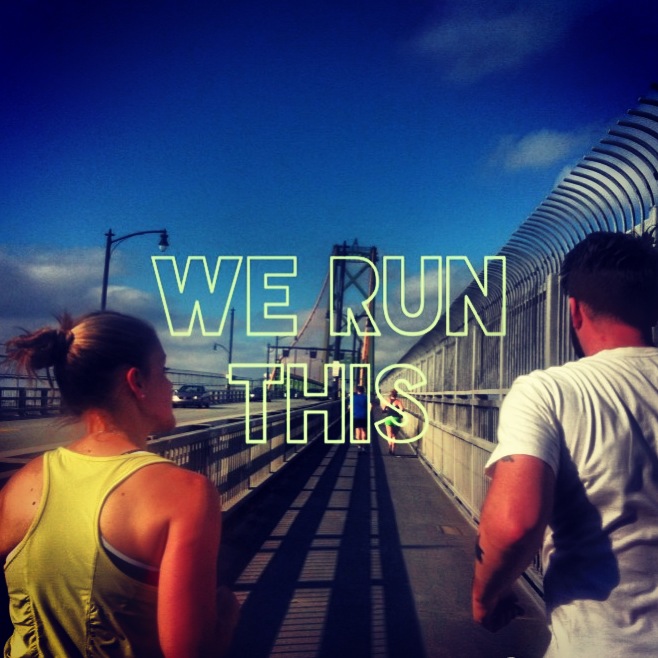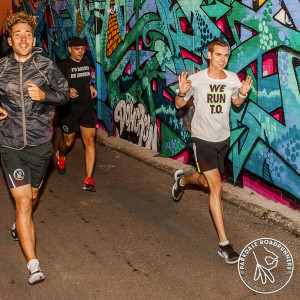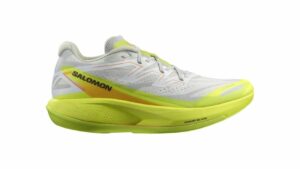Feature: The Crewsaders – Canada’s running crews
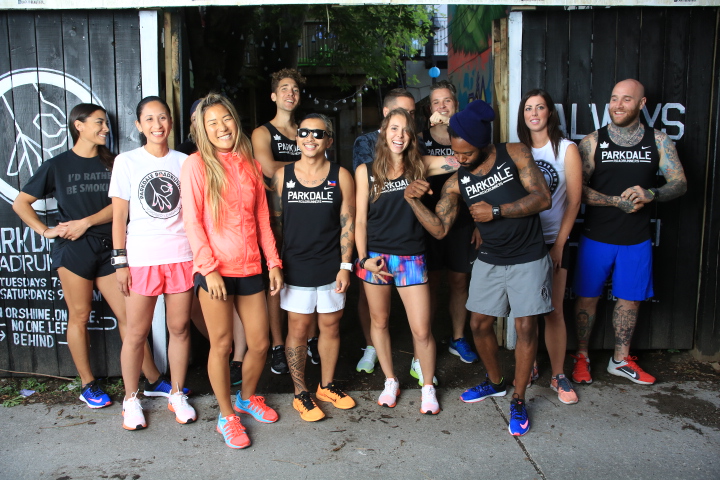
A new kind of running group that emphasizes camaraderie over competition is catching on across Canada, leading droves of young runners to lace up later at night
By Madeleine Cummings
In Toronto, it started with two T-shirts that said, “I’d rather be smoking.” Mike Krupica and Steven Artemiw were old friends with a new running habit, and in the summer of 2010, they threw on their ironic shirts and started going for runs up and down the streets of Parkdale. The shirts were a hit – earning them catcalls and car honks and then a cult following. People on the street starting asking if they could join up with the guys and customers at Krupica’s café (their meeting spot) kept asking when their run club met. For a while, the joke was there wasn’t a run club. But could there be?
Having never run with more than one other person before, Artemiw had some homework to do. He searched online for running clubs in Toronto and found track clubs, Running Room clinics and charity teams. He noticed that most had either a strict structure or no structure at all. Some charged fees; others didn’t. But almost all of the clubs he found had one thing in common: they met at 6 p.m. That definitely wasn’t going to work.
“I’m hard pressed to make it anywhere for six and I work nine to five,” he says. “I have friends who are bar owners or retail people. Life doesn’t fit that schedule.” He and Krupica decided on Tuesday nights at 8 p.m. and called themselves the Mascot Running Club, after the name of the café. In four years, the crew that now goes by the Parkdale Roadrunners has missed just one Tuesday night run. “And that wasn’t our fault,” Krupica insists. “There was a Hollywood film shoot and we couldn’t get near the café.”
The Roadrunners live by three rules: they leave on time, they run rain or shine, and they never leave anyone behind (that last one was added after someone got lost and the guys had to send out a search party.) What began as two people in joke T-shirts with a goal of running a faster 10K has since grown into an army of sports-watch-wearing, high-fiving friends who swarm the streets of Parkdale with tattooed-arms pumping. Upwards of 70 people a night now crowd into the crew’s new headquarters at Community 54 on Queen Street. Most are in their twenties or thirties and reflect the neighborhood’s burgeoning creative scene. They are DJs and graphic designers, chefs and shopkeepers, old friends and new. Despite gathering in the heart of a happening neighborhood that’s full of hip bars and new restaurants, on Tuesday nights, this crew would rather be running.
Part of a Movement
When the Roadrunners began documenting their urban running adventures on Instagram, they discovered that there were other similar running groups popping up in cities around the world. A search for “#running” led them to crews like the Paris Running Club and London’s Run Dem Crew.
“It wasn’t a letdown to find out that other people were doing it,” Artemiw explains. “It was entirely validating that the idea we had was not only a good idea for us and good for our community but it was good on a grander scale.” The idea had seemingly been replicated all over the place, he says, but the origins of the running crew movement (what some call #crewlove on social media) can be traced back to one man in New York City.
“We were the first crew,” says Mike Saes, a New Yorker who started NYC Bridge Runners ten years ago. During hot summer nights in June of 2004, Saes and a few friends took to running across the city’s bridges. They quickly gained a following – plus some sponsorship dollars from Nike – and ran en masse to local restaurants and bars. The runs became a way to explore the city’s culture but they also came to embody a culture of their own. To this day, the Bridge Runners run brazenly through car-clogged streets, cheering each other through red stoplights and on towards mystery destinations.
The movement spread, and once crews started to find out about each other, they planned events that combined running with partying and travel. In 2012, the Bridge Runners flew to Berlin for a race and there they met runners from a local crew, the Berlin Braves. The crews ran, raced, and socialized together, uniting for the first time under the phrase, “Bridge the Gap.” This led to more meet-ups in Amsterdam, Switzerland, Copenhagen, among other places. This past June, international crews finally congregated in North America for the first time to celebrate the Bridge Runners’ tenth anniversary.
According to Saes, the word “crew” has an urban graffiti-culture connotation. Crew runners assemble much like a group of graffiti artists do, moving swiftly about their cities and growing in size and strength. “Instead of becoming a club where you join and pay a membership and you wear heartrate monitors and eat granola together, we were a group of people who met in a bar and ran at three or four in the morning to sweat out the alcohol,” Saes says. Real runners, or “runnerds” as he calls them, wake up early to run laps around their local park. The Bridge Runners weren’t just about running around the city after a night at a bar, but they weren’t really about winning marathons either. The difference between crews and clubs, he says, is literally night and day. “They run at sunrise and we run after sunset.”
The North End Bridge Runners of Halifax also reject the “run club” label. “Why say club?” asks Sarah Riley, its energetic founder. “A club sounds like something your dad went to. Clubs have secretaries. We just have a meeting time and a place.”
While she was in her twenties, Riley had started running with the Running Rats, a run club that meets at a Running Room store in downtown Toronto. She could tell the group was well-established and certainly very organized, but felt its members were of an older demographic. The club’s vibe felt a little stuffy and serious to for a young woman whose workout attire often included an AC/DC t-shirt.
The Mascot Running Club, then developing in Parkdale, was much more her style. “For the first time I felt like I was running with people who are like me, who have the same attitude as I do, who visit the same coffee shops and who have the same type of life,” she says. “We have goals but we can still have fun.”
When Riley moved home to the Maritimes, she took what was happening in Parkdale and ran with it in Halifax. She made T-shirts, mapped a route, and directed local runners to a brewery in the city’s North End. Word spread among friends and on social media, and before long, she had a small pack meeting every Wednesday for a run, burgers and beers.
Similar run crews have sprung up across the country. After a business trip to Toronto and a few runs with the Parkdale Roadrunners, Jean-Philippe Lalonde started his own crew in Montreal. The young marketer had been logging solitary miles that winter on the treadmill, but launched the East Laurier Running Club as soon as he got home. He followed all the crews he could find on social media and reached out to local runners who were already posting about running in the city.
Ryan Chilibeck, a restaurant owner in Vancouver, started East Van Run Crew with the goal of meeting more like-minded people. He knew that Vancouver had a thriving running community but sensed that clubs were more about working on PBs than getting together for post-run beers. After asking friends and coworkers to join him for runs, he started posting ads on Craigslist.
Though running crews prioritize participation over competition, priding themselves on being as inclusive and accessible as possible, that doesn’t mean they don’t get competitive. When Chad Gilbert, a 28-year-old engineering contractor, joined the North End Bridge Runners, he couldn’t run 10K. Now he’s chasing the sub-40-minute mark. Club leader Sarah Riley remembers having to loop back at the end of a 4K run to meet Gilbert at the finish. “We never thought of him as a competitive runner,” she says. Gilbert, who met his current girlfriend during a crew run (“she took off at the end of the 6K and I had to catch up”), now almost never skips a Wednesday.
Recognizing the benefits of interval training for runners hoping to cut minutes off their personal bests, both the Parkdale Roadrunners and the East Laurier Run Club now host track sessions once a week. And as the running crew movement gains momentum, new crews looking to fuse competitive and collaborative running are taking off.
“We definitely have a competitive streak,” says Andrew Thuss, who started Manic Runners with Brennan Harvey two years ago in Toronto. The pair met through a group that ran out of a Nike store but started their own crew because they craved longer runs and more marathon training. Manic Runners might be more likely to arrive late to runs, espressos in hands, but once out on the roads, the faster runners really start to push each other and hit paces you might see in a race.
This year, Manic Runners developed a training guide for members interested in committing to running goals. It included instructions on strength training, pace groups, and how to taper before races. One runner who stuck to the program dropped 20 minutes from his marathon time.
Instagram has enabled the growth of a running movement that’s at times as much about socializing, style and sharing images as it is about actually running. “The trend is you have people who want to run as a social experience, rather than just for pure performance,” says Lalonde, of the East Laurier Running Club.
Crew runs are supposed to be more than group exercise. They’re a way of meeting new people and experiencing new places. Knowing crews existed in cities like Rome and Amsterdam helped bring Lalonde out of his shell while he travelled to Europe for business, for example. And when some of the Parkdale Roadrunners showed up at the NYC Bridge Runners’ anniversary event, members from crews around the world showered them with hugs as if they were all long lost friends.
“Running has gone from a single person sport to a social sport, perhaps overnight,” says Manic Runners founder Brennan Harvey. Though he respects how much Instagram has brought crews together, he sometimes worries that runners’ preoccupation with posting photos can take away from the purpose of meeting up. At Manic Runners, he and Thuss like to say, “We’re more about the miles, not the photos.”
Mike Saes of NYC Bridge Runners, on the other hand, insists that photos are part of what defines the crew movement. Running as a crew, he says, is less about harnessing natural speed (because not everyone has it) and more about connecting with your surroundings and appreciating the journey of each run. “It should be about exploring,” he says. “It’s more about making running part of your lifestyle than just becoming a runner.”
Though it can be a distraction, Instagram can also be an inspiration. At least it was for Aimee Laurel, of Toronto’s Night Terrors crew. After seeing a photo of women wearing head lamps and gearing up to for a night run around Brooklyn, Laurel couldn’t help but copy the idea. “I just thought that was the coolest thing ever,” she said of the photo. And so she grabbed a friend and started running around downtown Toronto at night. Plenty of her friends worked irregular hours so the unconventional meeting time of 11 p.m. worked well for them. Part of the attraction for people was the thrill of running when you’re not supposed to, she says, but for some, the posted photos can contribute to a sense of accomplishment. In the crew’s early stages, Laurel would choose a local landmark for the group to pose beside post-run.
As crews grow, maintaining inclusivity – something at the core of so many crew mantras – might mean splintering into smaller pace groups. London’s Run Dem Crew has become so popular that it now has five different groups that run at various speeds.
The East Laurier runners in Montreal, still a small crew by Canadian and international standards, are already struggling to stick together. “We’re seeing our group evolve and grow, and it’s challenge for us to operate because we have to convince the faster guys to slow down the pace or have the slower runners speed up,” Lalonde says.
Maintaining gender balance could be another hurdle, as many crews tend to have more men than women show up. Recognizing that some women feel more comfortable running with other women, the Parkdale Roadrunners now have women-only runs on Saturday mornings. Manic Runners in Toronto have actually seen their ratio start to skew in the other direction. “As we grow people are seeing us as more approachable,” Harvey says, with Thuss adding, “I think that the girls that have come out and enjoyed the vibe will bring a friend that will get introduced to the group. That way they know that they have someone that they can run with.”
Though crews have developed according to the values of their individual founders and been shaped by the cultures of their unique communities, anyone who has run with a crew has experienced what members of traditional running clubs have known for centuries – that running with others can be energizing and addictive.
One of Ryan Chilibeck’s most memorable crew runs started in East Vancouver and ended two cities away, in New Westminster. “It just clicked,” he says, describing a route that crossed all of Burnaby and ended with a Sky Train trip home. The kilometres had amassed effortlessly as the group ran farther than they ever had before. “Everyone helped each other and everyone just kept going. That’s when it started to feel real.”
Tips for Starting Your Own Run Crew
Pick a Meeting Spot
Find a place people already spend time in, like a shop or café, and approach its owner about starting a run crew. The place should be easy to find and open late. The North End Bridge Runners of Halifax meet at a microbrewery, where they can easily pass an hour over beers after a tough run.
Gather Your Troops
Gary Bone helps run a crew out of Livestock, the shoes-and-clothing store he owns in Vancouver. “We often get drop-in runners who are customers,” he says, “as well as a core of ten staffers who always show up.” Ryan Chilibeck of East Van Run Crew suggests using Craigslist to spread the word. It’s free and will attract people not already following you on Twitter and Facebook.
Get On Social Media
Start following crews on Facebook, Twitter and Instagram. From East to West, some Canadian run crews on Twitter include: @JunctionRC, @Parkdale_RR, @ManicRunClub, @NIGHTTERRORSRUN, @EastLaurierRun, and @NEBridgeRunners. Once your crew gains momentum, post run updates and photos daily.
Make Your Mantra
Find a few words that describe how you run and stick to them. The “Bridge the Gap” movement has 10 Crew Commandments, which include phrases like, “Never Run Alone,” “Run Party Repeat,” and “Have Kicks Will Travel.
Go Hard, but Stay Safe
You’ll already be safer if you’re running in a pack at night, says Aimee Laurel of Night Terrors. Consider having a buddy system and wearing reflective clothing. “We wear typically light colors because we can’t trust drivers out there,” she says. “It’s upon us to remain vigilant on the roads.”
